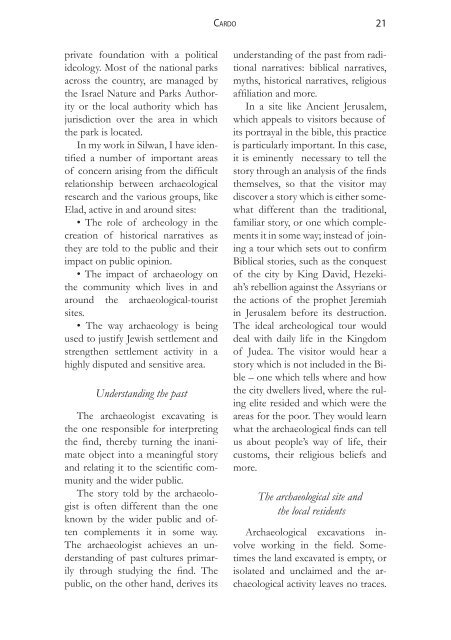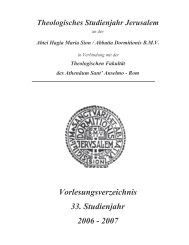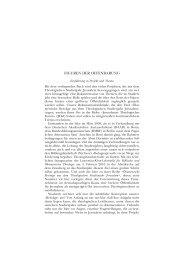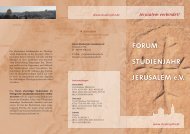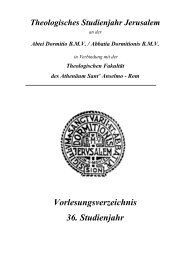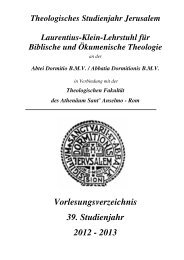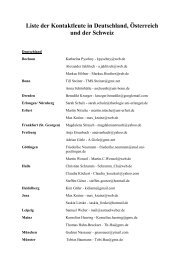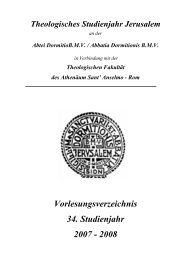Mit Bibel und Spaten? - Theologisches Studienjahr Jerusalem
Mit Bibel und Spaten? - Theologisches Studienjahr Jerusalem
Mit Bibel und Spaten? - Theologisches Studienjahr Jerusalem
Erfolgreiche ePaper selbst erstellen
Machen Sie aus Ihren PDF Publikationen ein blätterbares Flipbook mit unserer einzigartigen Google optimierten e-Paper Software.
private fo<strong>und</strong>ation with a political<br />
ideology. Most of the national parks<br />
across the country, are managed by<br />
the Israel Nature and Parks Authority<br />
or the local authority which has<br />
jurisdiction over the area in which<br />
the park is located.<br />
In my work in Silwan, I have identified<br />
a number of important areas<br />
of concern arising from the difficult<br />
relationship between archaeological<br />
research and the various groups, like<br />
Elad, active in and aro<strong>und</strong> sites:<br />
• The role of archeology in the<br />
creation of historical narratives as<br />
they are told to the public and their<br />
impact on public opinion.<br />
• The impact of archaeology on<br />
the community which lives in and<br />
aro<strong>und</strong> the archaeological-tourist<br />
sites.<br />
• The way archaeology is being<br />
used to justify Jewish settlement and<br />
strengthen settlement activity in a<br />
highly disputed and sensitive area.<br />
Understanding the past<br />
The archaeologist excavating is<br />
the one responsible for interpreting<br />
the find, thereby turning the inanimate<br />
object into a meaningful story<br />
and relating it to the scientific community<br />
and the wider public.<br />
The story told by the archaeologist<br />
is often different than the one<br />
known by the wider public and often<br />
complements it in some way.<br />
The archaeologist achieves an <strong>und</strong>erstanding<br />
of past cultures primarily<br />
through studying the find. The<br />
public, on the other hand, derives its<br />
Cardo 21<br />
<strong>und</strong>erstanding of the past from raditional<br />
narratives: biblical narratives,<br />
myths, historical narratives, religious<br />
affiliation and more.<br />
In a site like Ancient <strong>Jerusalem</strong>,<br />
which appeals to visitors because of<br />
its portrayal in the bible, this practice<br />
is particularly important. In this case,<br />
it is eminently necessary to tell the<br />
story through an analysis of the finds<br />
themselves, so that the visitor may<br />
discover a story which is either somewhat<br />
different than the traditional,<br />
familiar story, or one which complements<br />
it in some way; instead of joining<br />
a tour which sets out to confirm<br />
Biblical stories, such as the conquest<br />
of the city by King David, Hezekiah’s<br />
rebellion against the Assyrians or<br />
the actions of the prophet Jeremiah<br />
in <strong>Jerusalem</strong> before its destruction.<br />
The ideal archeological tour would<br />
deal with daily life in the Kingdom<br />
of Judea. The visitor would hear a<br />
story which is not included in the Bible<br />
– one which tells where and how<br />
the city dwellers lived, where the ruling<br />
elite resided and which were the<br />
areas for the poor. They would learn<br />
what the archaeological finds can tell<br />
us about people’s way of life, their<br />
customs, their religious beliefs and<br />
more.<br />
The archaeological site and<br />
the local residents<br />
Archaeological excavations involve<br />
working in the field. Sometimes<br />
the land excavated is empty, or<br />
isolated and unclaimed and the archaeological<br />
activity leaves no traces.


